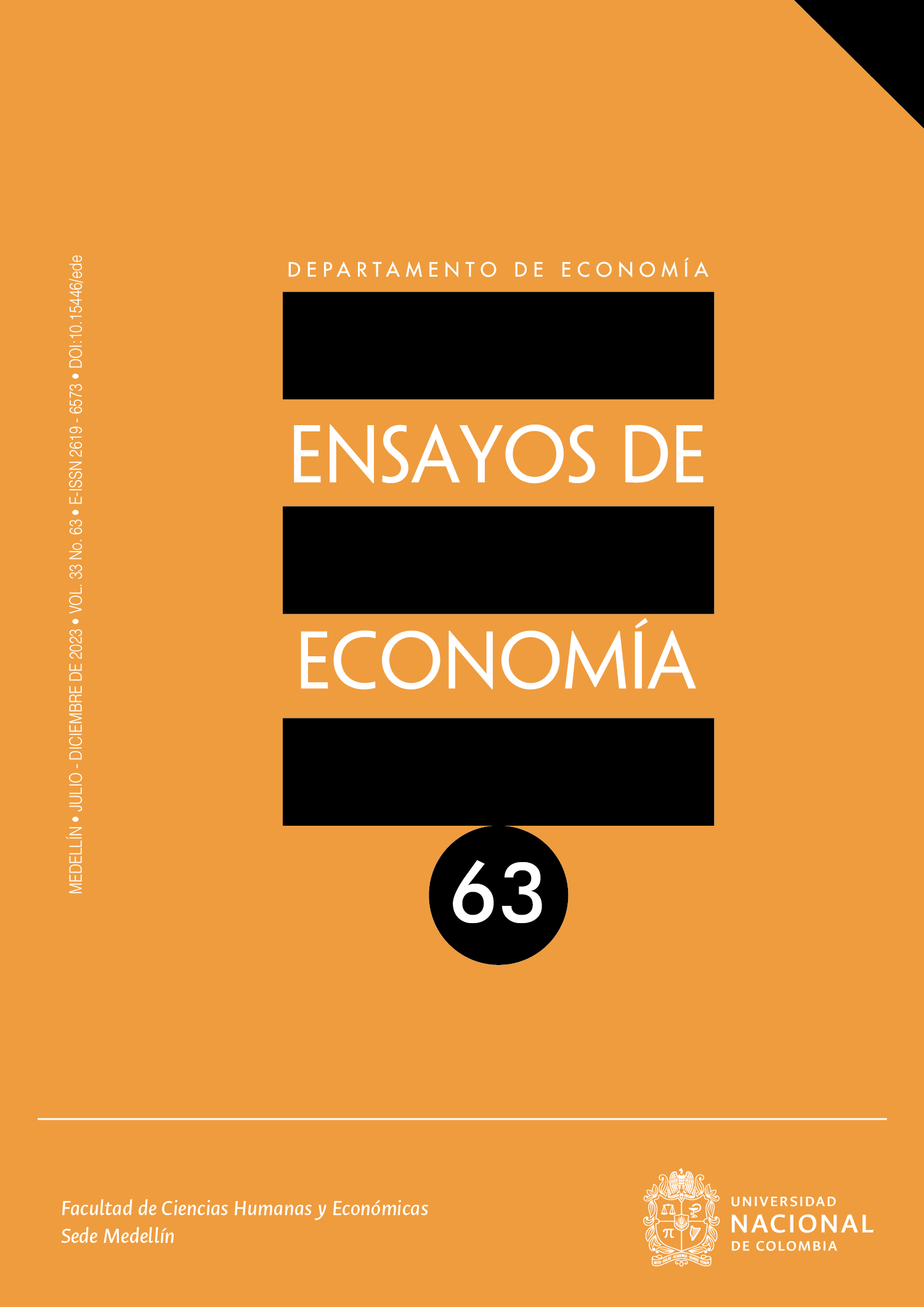¿Qué impulsa la adopción de CBDC o bitcoin? Evidencia derivada de la experiencia del Caribe, Centroamérica y Sudamérica
What Drives the Adoption of CBCD or Bitcoin? Evidence from the Caribbean, Central and South America Experience
O que impulsiona a adoção de CBDC ou bitcoin? Evidências da experiência do Caribe e das Américas Central e do Sul
DOI:
https://doi.org/10.15446/ede.v33n63.105413Palabras clave:
CBDC, monedas digitales, política monetaria, inclusión financiera, innovación de bancos centrales, dinero digital (es)CBDC, digital currencies, monetary policy, financial inclusion, central bank innovation, digital currency (en)
CBDC, moedas digitais, política monetária, inclusão financeira, inovação do banco central, dinheiro digital (pt)
Descargas
Los países de la región del Caribe, Centroamérica y Sudamérica han irrumpido con fuerza e indiscutible liderazgo en la adopción del dinero digital, ya sea apostando por las monedas digitales emitidas y respaldadas por un banco central (CBDC) o por las monedas virtuales descentralizadas (DEFI), lideradas por Bitcoin y Ether. El objetivo del artículo es identificar las razones que llevan a un país o zona monetaria a decantarse por alguno de estos sistemas. Una vez estudiadas las ventajas y desventajas del uso de las divisas virtuales centraremos el análisis en doce variables sobre el uso de dinero móvil extraídas del GFI (Global Findex Indicator) de los años 2011, 2014, 2017 y 2021 de todos estos países. El presente artículo demuestra, entre otras cuestiones, que la apuesta por un dinero digital basado en CBDC o DEFI depende más de la elección política de los dirigentes del país en cuestión que de criterios socioeconómicos.
The countries of the Caribbean region, Central America and South America have emerged with strength and undisputed leadership in the adoption of digital money, either by betting on digital currencies issued and backed by a central bank (CBDC) or by decentralized virtual currencies (DEFI), led by Bitcoin and Ether. This article aims to identify the reasons that lead a country or currency area to opt for one of these systems. After studying the advantages and disadvantages of using virtual currencies, we will focus the analysis on twelve variables of the use of mobile money extracted from the GFI (Global Findex Indicator) for 2011, 2014, 2017, and 2021 for all these countries. This article shows, among other things, that the commitment to digital money based on CBDC or DEFI depends more on the political choice of the governments than on socioeconomic criteria.
Os países da região do Caribe e das Américas Central e do Sul emergiram como líderes fortes e incontestáveis na adoção da moeda digital, seja optando por moedas digitais emitidas e respaldadas por um banco central (CBDC) ou por moedas virtuais descentralizadas (DEFI), lideradas pelo Bitcoin e pelo Ether. O objetivo do artigo é identificar os motivos que levam um país ou área monetária a optar por um desses sistemas. Depois de estudar as vantagens e desvantagens do uso de moedas virtuais, concentraremos nossa análise em doze variáveis sobre o uso de dinheiro móvel extraídas do GFI (Global Findex Indicator) para 2011, 2014, 2017 e 2021 para todos esses países. Este artigo demonstra, entre outras coisas, que o compromisso com o dinheiro digital baseado em CBDC ou DEFI depende mais da escolha política dos líderes do país em questão do que de critérios socioeconômicos.
Referencias
Aker, J. C., Boumnijel, R., McClelland, A., & Tierney, N. (2016). Payment Mechanisms and antipoverty programs: Evidence from A Mobile Money Cash Transfer Experiment in Niger. Economic Development and Cultural Change, 65(1), 1-37. https://doi.org/10.1086/687578 DOI: https://doi.org/10.1086/687578
Akinyemi, B. E., & Mushunje, A. (2020). Determinants of Mobile Money Technology Adoption in Rural Areas of Africa. Cogent Social Sciences, 6(1), 1815963. https://doi.org/10.1080/23311886.2020.1815963 DOI: https://doi.org/10.1080/23311886.2020.1815963
Alfar, A. J. K., Kumpamool, C., Nguyen, D. T. K., & Ahmed, R. (2023). The Determinants of Issuing Central Bank Digital Currencies. Research in International Business and Finance, 64, 101884. https://doi.org/10.1016/j.ribaf.2023.101884 DOI: https://doi.org/10.1016/j.ribaf.2023.101884
Alonso, S. L. N., Jorge-Vázquez, J., Rodríguez, P. A., & Hernández, B. M. S. (2023). Gender Gap in The Ownership and Use of Cryptocurrencies: Empirical Evidence from Spain. Journal of Open Innovation: Technology, Market, and Complexity, 9(3), 100103. https://doi.org/10.1016/j.joitmc.2023.100103 DOI: https://doi.org/10.1016/j.joitmc.2023.100103
Ammous, S. (2018). El patrón Bitcoin: La alternativa descentralizada a los bancos centrales. Deusto.
Amoah, A., Korle, K., & Asiama, R. K. (2020). Mobile Money as a Financial Inclusion Instrument: What Are the Determinants? International Journal of Social Economics, 47(10), 1283-1297. https://doi.org/10.1108/ijse-05-2020-0271 DOI: https://doi.org/10.1108/IJSE-05-2020-0271
Arauz, A., Garratt, R., & Ramos F., D. F. (2021). Dinero Electrónico: The rise and fall of Ecuador’s central bank digital currency. Latin American Journal of Central Banking, 2(2), 100030. https://doi.org/10.1016/j.latcb.2021.100030 DOI: https://doi.org/10.1016/j.latcb.2021.100030
Asamblea Legislativa de la República de El Salvador. (2021, 9 de junio). Decreto 57. https://www.jurisprudencia.gob.sv/DocumentosBoveda/D/2/2020-2029/2021/06/E75F3.PDF
Auer, R., Cornelli, G., & Frost, J. (2020). Rise of the Central Bank Digital Currencies: Drivers, Approaches and Technologies. In BIS (pp. 1–29). Bank for International Settlements. https://www.bis.org/publ/work880.htm DOI: https://doi.org/10.2139/ssrn.3724070
Auer, R., & Tercero-Lucas, D. (2022). Distrust or Speculation? The Socioeconomic Drivers of U.S. Cryptocurrency Investments. Journal of Financial Stability, 62, 101066. https://doi.org/10.1016/j.jfs.2022.101066 DOI: https://doi.org/10.1016/j.jfs.2022.101066
Ayuso, J., & Conesa, J. C. (2020). Una introducción al debate actual sobre la moneda digital de banco central (CBDC) [working paper No. 2005]. Banco de España. https://doi.org/10.2139/ssrn.3617558 DOI: https://doi.org/10.2139/ssrn.3617558
Banco Mundial. (s.f.). Global Findex database. Global Findex Indicator. Consultado el dd de mm de 2022. https://www.worldbank.org/en/publication/globalfindex#data_sec_focus
Banco Central de Honduras (BCH). (2022, 23 de marzo). Comunicado. https://www.bch.hn/administrativas/RI/Enlaces%20Comunicados%20FMI%20%20ES/Comunicado%20sobre%20la%20posible%20adopci%C3%B3n%20del%20Bitcoin%20como%20moneda%20de%20curso%20legal%20del%20pa%C3%ADs.pdf
Bech, M. L., & Garratt, R. (2017). Central Bank Cryptocurrencies. En Bank for International Settlements (ed.), BIS Quarterly Review. International Banking and Financial Market Developments (pp. 55–70). https://www.bis.org/publ/qtrpdf/r_qt1709.pdf
Cohen, N.; Rubinchik, A., Shami, L. (2020). Towards a Cashless Economy: Economic and Socio-Political Implications. European Journal of Political Economy, 61, 101820. https://doi.org/10.1016/j.ejpoleco.2019.101820 DOI: https://doi.org/10.1016/j.ejpoleco.2019.101820
De Ampuero, D., Chachanosky, N., Echarte, M. Á., Espinosa, L., Emanuele, C. J., Hinds, M., López, F., Paredes, P. L., Ravier, A., Alemán, P. R., White, L. H., & Zalles, F. (2022). Ecuador, un país dolarizado: pasado, presente y futuro. USFQ Press.
Ebong, J., & George, B. (2021). Financial Inclusion through Digital Financial Services (DFS): A Study in Uganda. Journal of Risk and Financial Management, 14(9), 393. https://doi.org/10.3390/jrfm14090393 DOI: https://doi.org/10.3390/jrfm14090393
Echarte-Fernández, M. Á. (2019). La dolarización en América Latina. Unión Editorial.
Echarte-Fernández, M. Á. (2022). La política monetaria de los bancos centrales durante la pandemia de la Covid-19: un análisis de los estímulos monetarios y del surgimiento de las divisas virtuales centralizadas. En C. Albarrán-Fernández & D. Sanz-Bas (eds.), Desafíos de la economía ante la Covid-19: globalización, políticas públicas y economía social (pp. 70-95). Tirant lo Blanch.
Echarte-Fernández, M. Á., & Martínez Hernández, M. (2018). Análisis de los efectos de la dolarización espontánea y oficial en Hispanoamérica: la perspectiva keynesiana y liberal del sistema monetario. Revista Lasallista de Investigación, 15(2), 33-48. https://doi.org/10.22507/rli.v15n2a3 DOI: https://doi.org/10.22507/rli.v15n2a3
Economides, N., & Jeziorski, P. (2017). Mobile Money in Tanzania. Marketing Science, 36(6), 815–837. https://doi.org/10.1287/mksc.2017.1027 DOI: https://doi.org/10.1287/mksc.2017.1027
Edwards, S. (2021). Central Bank Digital Currencies and The Emerging Markets:The Currency Substitution Challenge [NBER working paper No. 29489]. National Bureau of Economic Research. http://dx.doi.org/10.3386/w29489 DOI: https://doi.org/10.3386/w29489
Engert, W.; Fung, B., & Hendry, S. (2018). Is a Cashless Society Problematic? [Staff DiscussionPaper No. 2018/12]. Bank of Canada. https://publications.gc.ca/collections/collection_2018/banque-bank-canada/FB3-6-2018-12-eng.pdf
Feeney, M. (2022, 2 de marzo). Bitcoin won’t rescue Russian oligarchs from sanctions. Policy Commons. Cato Institute. https://policycommons.net/artifacts/2269610/bitcoin-wont-rescue-russian-oligarchs-from-sanctions/3029439/
Fundación Salvadoreña para el Desarrollo Económico y Social (Fusades). (2021). Ley Bitcoin: una ley que genera incertidumbre para los salvadoreños. Fundación Salvadoreña para el Desarrollo Económico y Social [informe]. https://fusades.org/publicaciones/DEC-DEL_Bitcoin.pdf
Gniadkowska-Szymańska, A., Olgić Draženović, B., & Suljic Nikolaj, S. (2022). Selected Cryptocurrency Returns and Capital Gains Tax - Based on the Example of Countries with Varying Degrees of Legal Regulations Concerning Cryptocurrencies. Finanse i Prawo Finansowe, 3(35), 53–64. https://doi.org/10.18778/2391-6478.3.35.04 DOI: https://doi.org/10.18778/2391-6478.3.35.04
Goh, Y.Y.; Leong, S.H.; Pang, M.W.; Yew, S.K., & Yow, Z.L. The Effects of Cashless Payments on Corruption [Bachelor’s Thesis, Universiti Tunku Abdul Rahmanutar]. http://eprints.utar.edu.my/3535/1/fyp_FN_2019_GYY.pdf
Gumba, B. G. (2018). Mobile Money in a Poor Fishing Municipality in the Philippines. Poverty & Public Policy, 10(1), 81-94. https://doi.org/10.1002/pop4.206 DOI: https://doi.org/10.1002/pop4.206
Hamdan, J. S., Lehmann-Uschner, K., & Menkhoff, L. (2021). Mobile Money, Financial Inclusion, and Unmet Opportunities. Evidence from Uganda. The Journal of Development Studies, 58 (4), 1-21. https://doi.org/10.1080/00220388.2021.1988078 DOI: https://doi.org/10.1080/00220388.2021.1988078
Hanke, S., Hanlon, N., & Chakravarthi, M. (2021). Bukele's Bitcoin Blunder (No. 185). The Johns Hopkins Institute for Applied Economics, Global Health, and the Study of Business Enterprise. https://bit.ly/3KB4bjX
Hinds, M. (2006). Playing Monopoly with the Devil: Dollarization and Domestic Currencies in Developing Countries. Yale University Press. DOI: https://doi.org/10.12987/yale/9780300113303.001.0001
Javed, Y., Al Qahtani, E., & Shehab, M. (2021). Privacy Policy Analysis of Banks and Mobile Money Services in the Middle East. Future Internet, 13(1), 10. https://doi.org/10.3390/fi13010010 DOI: https://doi.org/10.3390/fi13010010
Kaczmarek, P. (2022). Central Bank Digital Currency: Scenarios of Implementation and Potential Consequences for Monetary System. Journal of Central Banking Theory and Practice, 11(3), 137-154. https://doi.org/10.2478/jcbtp-2022-0027 DOI: https://doi.org/10.2478/jcbtp-2022-0027
Ky, S., Rugemintwari, C., & Sauviat, A. (2017). Does Mobile Money Affect Saving Behaviour? Evidence from a Developing Country. Journal of African Economies, 27(3), 285-320. https://doi.org/10.1093/jafeco/ejx028 DOI: https://doi.org/10.1093/jafeco/ejx028
Lederman, D., & Zouaidi, M. (2020). Incidence of the digital Economy and Frictional Unemployment: International Evidence [working paper]. World Bank. http://dx.doi.org/10.1596/1813-9450-9170 DOI: https://doi.org/10.1596/1813-9450-9170
Le, T.-H., Chuc, A. T., & Taghizadeh-Hesary, F. (2019). Financial Inclusion and Its Impact on Financial Efficiency and Sustainability: Empirical Evidence from Asia. Borsa Istanbul Review, 19(4), 310-322. https://doi.org/10.1016/j.bir.2019.07.002 DOI: https://doi.org/10.1016/j.bir.2019.07.002
Lee, S., & Adam, A. (2021). Designing a Logic Model for Mobile Maternal Health e-Voucher Programs in Low- and Middle-Income Countries: An Interpretive Review. International Journal of Environmental Research and Public Health, 19(1), 295. https://doi.org/10.3390/ijerph19010295 DOI: https://doi.org/10.3390/ijerph19010295
Liu, C., Zhang, X., & Medda, F. (2021). Euro CBDC: A regime to enhance the next generation EU fund. SSRN Electronic Journal.https://doi.org/10.2139/ssrn.3824961 DOI: https://doi.org/10.2139/ssrn.3824961
Liu, Y., & Tsyvinski, A. (2021). Risks and Returns of Cryptocurrency. The Review of Financial Studies, 34(6), 2689-2727. https://doi.org/10.1093/rfs/hhaa113 DOI: https://doi.org/10.1093/rfs/hhaa113
Liu, Y., Tsyvinski, A., & Wu, X. (2022). Common Risk Factors in Cryptocurrency. The Journal of Finance, 77(2), 1133-1177. https://doi.org/10.1111/jofi.13119 DOI: https://doi.org/10.1111/jofi.13119
Lutfi, A., Al-Okaily, M., Alshirah, M. H., Alshira’h, A. F., Abutaber, T. A., & Almarashdah, M. A. (2021). Digital Financial Inclusion Sustainability in Jordanian Context. Sustainability, 13(11), 6312. https://doi.org/10.3390/su13116312 DOI: https://doi.org/10.3390/su13116312
Maldonado, J. (2021, 28 de junio). Chivo, la wallet de Bitcoin de El Salvador que donará $30 dólares a cada usuario. Bit2Me News. https://news.bit2me.com/chivo-la-futura-wallet-de-bitcoin-de-el-salvador/
Mcintosh, D. (2022, 10 de marzo). $2500 Incentive for Jamaicans to Get Digital Wallet. Jamaica Information Service. https://jis.gov.jm/2500-incentive-for-jamaicans-to-get-digital-wallet/
Migration Data (s.f.). Número total de emigrantes 2020. Consultado el 24 de marzo de 2022. https://www.migrationdataportal.org/es/international-data?i=stock_abs_origin&t=2020&cm49=724
Myeni, S., Makate, M., & Mahonye, N. (2020). Does Mobile Money Promote Financial Inclusion in Eswatini? International Journal of Social Economics, 47(6), 693-709. https://doi.org/10.1108/ijse-05-2019-0310 DOI: https://doi.org/10.1108/IJSE-05-2019-0310
Náñez-Alonso, S. L., Echarte-Fernández, M. Á., Sanz-Bas, D., & Kaczmarek, J. (2020). Reasons fostering or discouraging the implementation of central bank-backed digital currency: A review. Economies, 8(2), 41. https://doi.org/10.3390/economies8020041 DOI: https://doi.org/10.3390/economies8020041
Náñez-Alonso, S. L., Jorge-Vazquez, J., & Reier-Forradellas, R. F. (2021a). Central Banks Digital Currency: Detection of Optimal Countries for The Implementation of a CBDC and The Implication for Payment Industry Open Innovation. Journal of Open Innovation: Technology, Market, and Complexity, 7(1), 72. https://doi.org/10.3390/joitmc7010072 DOI: https://doi.org/10.3390/joitmc7010072
Náñez-Alonso, S. L., Jorge-Vázquez, J., Echarte Fernández, M. Á., & Reier Forradellas, R. F. (2021b). Cryptocurrency mining from an economic and environmental perspective. Analysis of the most and least sustainable countries. Energies, 14(14), 4254. https://doi.org/10.3390/en14144254 DOI: https://doi.org/10.3390/en14144254
Náñez-Alonso, S. L., Echarte Fernández, M. Á., Jorge-Vázquez, J., & Szymla, W. (2022). CBDC y DEFI en el Caribe, Sudamérica y Centroamérica: Análisis de la situación. In Digitalización de empresas y economía: Tendencias Actuales (pp. 282–306). Dykinson. Madrid.
Ngugi, B., Pelowski, M., &; Ogembo, J. G. (2010). M-pesa: A Case Study of the Critical Early Adopters’ Role in the Rapid Adoption of Mobile Money Banking in Kenya. The Electronic Journal of Information Systems in Developing Countries, 43(1), 1-16. https://doi.org/10.1002/j.1681-4835.2010.tb00307.x DOI: https://doi.org/10.1002/j.1681-4835.2010.tb00307.x
Ozili, P. K. (2022). Circular Economy and Central Bank Digital Currency. Circular Economy and Sustainability, 2. https://doi.org/10.1007/s43615-022-00170-0 DOI: https://doi.org/10.2139/ssrn.4164317
Rivadeneyra, I., Suthers, D. D., & Juarez, R. (2022). Mobile money networks with tax-incentives. Humanities and Social Sciences Communications, 9(1). https://doi.org/10.1057/s41599-022-01075-x DOI: https://doi.org/10.1057/s41599-022-01075-x
Rotondi, V., & Billari, F. C. (2021). Mobile Money and School Participation: Evidence from Africa. Population Research and Policy Review, 41(1), 343–362. https://doi.org/10.1007/s11113-021-09641-y DOI: https://doi.org/10.1007/s11113-021-09641-y
Sanchez-Roger, M., & Puyol-Antón, E. (2021). Digital Bank Runs: A Deep Neural Network Approach. Sustainability, 13(3), 1513. https://doi.org/10.3390/su13031513 DOI: https://doi.org/10.3390/su13031513
Sanz-Bas, D., Del Rosal, C., Náñez Alonso, S. L., & Echarte Fernández, M. Á. (2021). Cryptocurrencies and Fraudulent Transactions: Risks, Practices, and Legislation for Their Prevention in Europe and Spain. Laws, 10(3), 57. https://doi.org/10.3390/laws10030057 DOI: https://doi.org/10.3390/laws10030057
Sekabira, H., & Qaim, M. (2017). Mobile Money, Agricultural Marketing, and Off-Farm Income in Uganda. Agricultural Economics, 48(5), 597–611. https://doi.org/10.1111/agec.12360 DOI: https://doi.org/10.1111/agec.12360
Siva-Facetti, F., Apuril, A., & Ramtez, J. B. (2021, 14 de julio). Proyecto de Ley. Que regula la industria y comercialización de activos virtuales— criptoactivos. https://www.uip.org.py/wp-content/uploads/2021/07/antesedentes-regulacion-industria-activos-virt.-criptomonedas.pdf
Srouji, J. (2020). Digital Payments, the Cashless Economy, and Financial Inclusion in the United Arab Emirates: Why is Everyone Still Transacting in Cash? Journal of Risk and Financial Management, 13(11), 260. https://doi.org/10.3390/jrfm13110260 DOI: https://doi.org/10.3390/jrfm13110260
Suri, T. (2017). Mobile Money. Annual Review of Economics, 9(1), 497-520. https://doi.org/10.1146/annurev-economics-063016-103638 DOI: https://doi.org/10.1146/annurev-economics-063016-103638
Suri, T., & Jack, W. (2016). The Long-Run Poverty and Gender Impacts of Mobile Money. Science, 354(6317), 1288-1292. https://doi.org/10.1126/science.aah5309 DOI: https://doi.org/10.1126/science.aah5309
Swiston, A. (2011). Official Dollarization as a Monetary Regime: Its Effects on El Salvador [IMF Working Papers No. 129]. https://doi.org/10.5089/9781455258390.001 DOI: https://doi.org/10.2139/ssrn.1864432
Taylor, L. (2022). The World’s First Bitcoin Republic. New Scientist, 253(3376), 14. https://doi.org/10.1016/s0262-4079(22)00360-8 DOI: https://doi.org/10.1016/S0262-4079(22)00360-8
Temperini, J., & Corsi, M. (2023). The Role of Cryptocurrencies in Democratizing Money [working paper]. https://doi.org/10.2139/ssrn.4323686 DOI: https://doi.org/10.2139/ssrn.4323686
Tengeh, R. K., & Gahapa Talom, F. S. (2020). Mobile Money as a Sustainable Alternative for Smes in Less Developed Financial Markets. Journal of Open Innovation: Technology, Market, and Complexity, 6(4), 163. https://doi.org/10.3390/joitmc6040163 DOI: https://doi.org/10.3390/joitmc6040163
Vučinić, M., & Luburić, R. (2022). Fintech, Risk-Based Thinking and Cyber Risk. Journal of Central Banking Theory and Practice, 11(2), 27–53. https://doi.org/10.2478/jcbtp-2022-0012 DOI: https://doi.org/10.2478/jcbtp-2022-0012
Wenker, K. (2022). Retail Central Bank Digital Currencies (CBDC), Disintermediation and Financial Privacy: The Case of the Bahamian sand Dollar. FinTech, 1(4), 345-361. https://doi.org/10.3390/fintech1040026 DOI: https://doi.org/10.3390/fintech1040026
Yildirim, E., Afşar, K. E., & Bektaş, R. (2023). Merkez Bankası Dijital Para Birimi: Tasarım ve Protokol Mekanizmaları Bağlamında Karşılaştırmalı Bir Analiz. Bilişim Teknolojileri Dergisi, 16(1), 55–66. https://doi.org/10.17671/gazibtd.1132632 DOI: https://doi.org/10.17671/gazibtd.1132632
Yin, X., Xu, X., Chen, Q., & Peng, J. (2019). The Sustainable Development of Financial Inclusion: How Can Monetary Policy and Economic Fundamental Interact with It Effectively? Sustainability, 11(9), 2524. https://doi.org/10.3390/su11092524 DOI: https://doi.org/10.3390/su11092524
Cómo citar
APA
ACM
ACS
ABNT
Chicago
Harvard
IEEE
MLA
Turabian
Vancouver
Descargar cita
CrossRef Cited-by
1. Sergio Luis Náñez Alonso, Peterson K. Ozili, Beatriz María Sastre Hernández, Luís Miguel Pacheco. (2025). Evaluating the acceptance of CBDCs: experimental research with artificial intelligence (AI) generated synthetic response. Quantitative Finance and Economics, 9(1), p.242. https://doi.org/10.3934/QFE.2025008.
2. Sergio Luis Náñez Alonso. (2023). Can Central Bank Digital Currencies be green and sustainable?. Green Finance, 5(4), p.603. https://doi.org/10.3934/GF.2023023.
3. Peterson K. Ozili, Sergio Luis Náñez Alonso. (2024). Central Bank Digital Currency Adoption Challenges, Solutions, and a Sentiment Analysis. Journal of Central Banking Theory and Practice, 13(1), p.133. https://doi.org/10.2478/jcbtp-2024-0007.
4. Juan-Francisco Albert, Nerea Gómez-Fernández, Sergio Luis Náñez Alonso. (2024). Global Developments in Central Bank Digital Currency. Advances in Finance, Accounting, and Economics. , p.68. https://doi.org/10.4018/979-8-3693-5588-6.ch005.
Dimensions
PlumX
Visitas a la página del resumen del artículo
Descargas
Licencia

Esta obra está bajo una licencia internacional Creative Commons Atribución-NoComercial-SinDerivadas 4.0.
Se autoriza la reproducción sin ánimo de lucro de los materiales, citando la fuente.





























